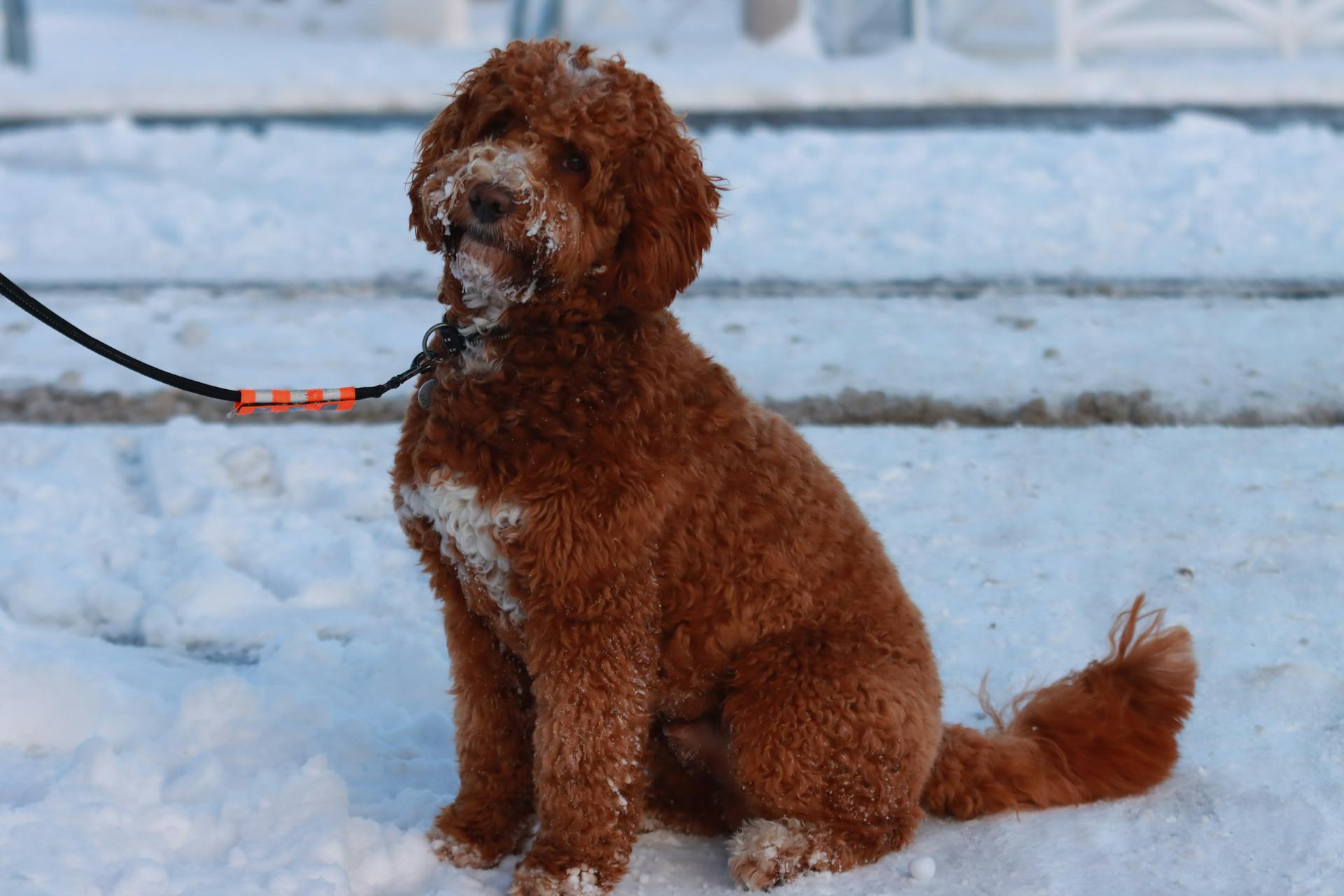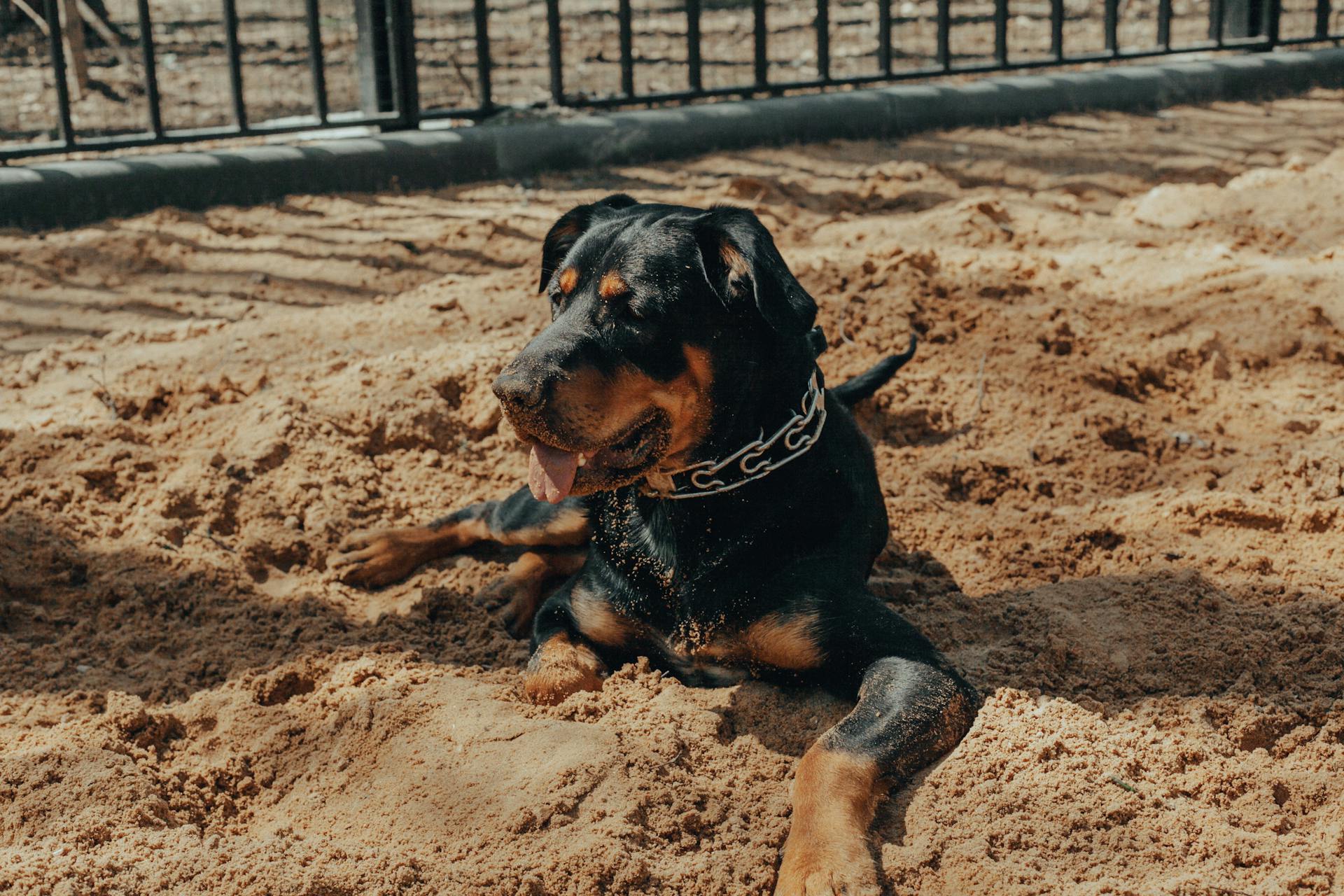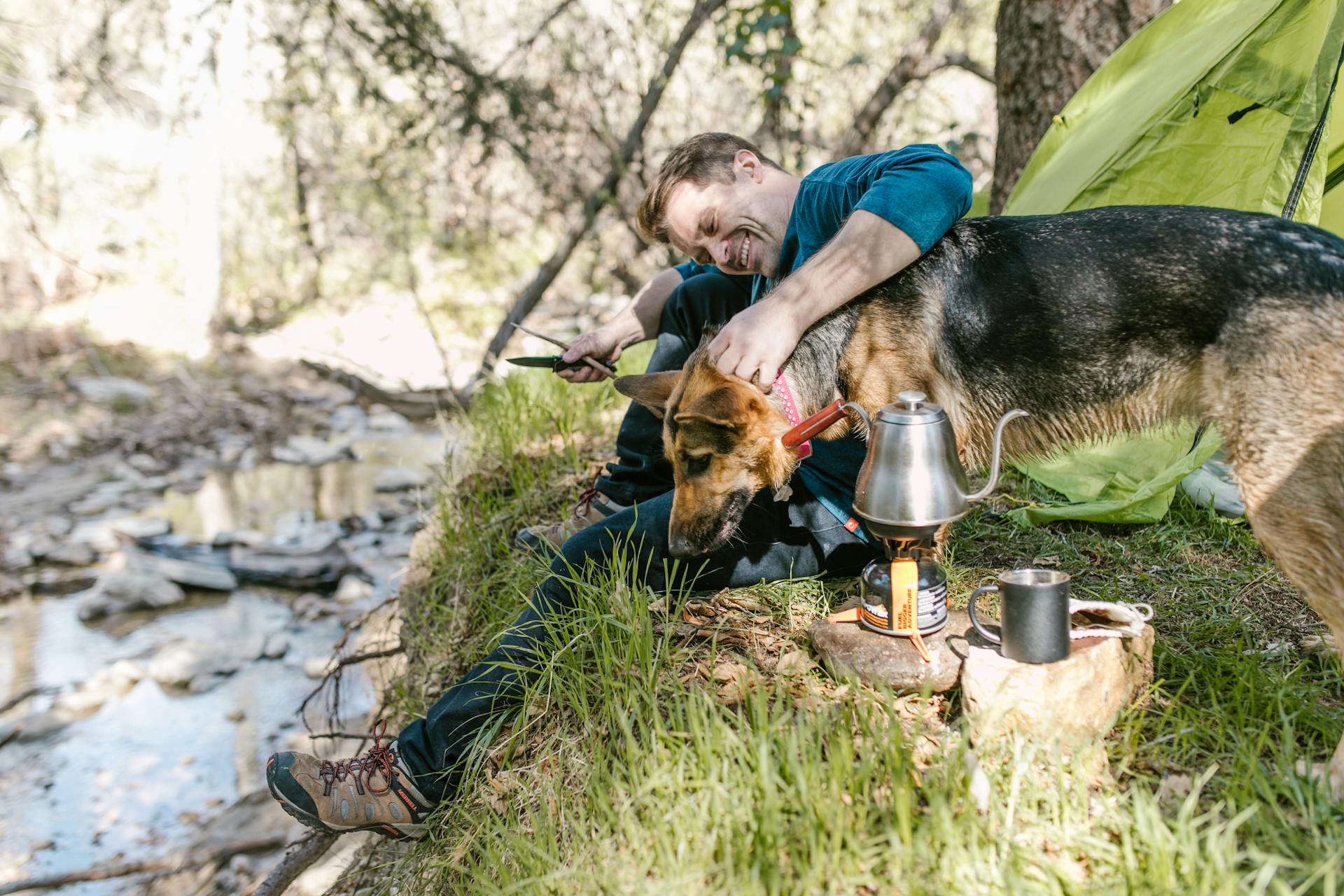
German Shepherds are highly intelligent dogs that require regular exercise to stay happy and healthy. They need at least 30 minutes of exercise per day, which can include walks, runs, or playtime in the yard.
Their high energy levels also make them prone to destructive behavior if left alone for too long. This is why many German Shepherd owners work from home or have a furry friend to keep them company.
To keep your German Shepherd's mind active, you can try puzzle toys filled with treats or interactive games like hide-and-seek. This will keep them engaged and stimulated for hours.
German Shepherds are also known for their loyalty and affection towards their families, making them great companions for active families or individuals.
Worth a look: Dogs Breeds That Start with B
Exercise and Care
German Shepherds are bred for activity and require daily exercise for release, which can help prevent boredom and undesirable behaviors. They need a combination of physical engagement, such as jogging and playtime at a dog park, and mental stimulation, like agility or obedience competitions.
To keep your German Shepherd happy and healthy, it's essential to watch their diet and make sure they get enough exercise. A daily 30-minute walk or more is a great starting point. They also enjoy exercise that incorporates physical and mental challenges, such as agility, parkour, tracking, and protection work.
German Shepherds are prone to skin problems, so they may need extra attention during bathing. Their double coat can shed considerably and may need daily brushing during shedding season. Otherwise, brushing once or twice a week will suffice. Regular brushing will help remove loose hairs and prevent matting.
Their diet is also crucial, as they need large-breed puppy food during development to reduce the risk of hip dysplasia and other joint disorders. Feeding high-quality dog food specifically for their age is essential to ensure they get all the nutrients they need. Avoid giving them table scraps often, as this can cause digestive problems.
Here's a list of regular care tasks to keep your German Shepherd happy and healthy:
- Brush their teeth regularly
- Keep their coat brushed too
- Stick to exam and vaccination schedules
- Watch out for unusual signs that something may be wrong
- Bathe them every couple of months, or sooner if they get dirty
- Trim their nails down once a month
German Shepherds need access to plenty of space to run and exercise in, making them more suitable for homes and families. They do best with positive, reward-based training and will bond with you and your family, making them want to please you.
Health
German Shepherds are generally a healthy breed, but like all breeds, they can be prone to certain health issues. Hip dysplasia is a common concern, affecting around 19.1% of German Shepherds, according to the Orthopedic Foundation for Animals.
Hip dysplasia occurs when the hip joint doesn't fit together properly, leading to arthritis and pain. This condition can be detected through X-ray assessments and is a major reason why German Shepherds should not be used for breeding if they have it.
Elbow dysplasia is another issue that affects large breeds like German Shepherds, causing joint instability and painful lameness. Veterinary recommendations may include surgical intervention or pain management medications.
Bloat is a life-threatening condition that can occur in deep-chested dogs like German Shepherds. It happens when the stomach fills with gas or air and twists, cutting off the blood supply and causing shock. Signs of bloat include an enlarged abdomen, retching, drooling, restlessness, and whining when the abdomen is touched.
Related reading: Bloat in German Shepherds
Degenerative myelopathy is a progressive spinal cord condition that affects the hind legs, causing weakness and potentially leading to paralysis. Treatment options are limited, but vitamin deficiencies may be involved in rare cases.
Exocrine pancreatic insufficiency (EPI) is a genetic disorder that affects the pancreas, leading to impaired digestion and absorption of food. Symptoms include gas, appetite loss, weight loss, altered stools, and increased hunger. Diagnosis is straightforward through a blood test, and treatment involves adding pancreatic enzymes to the dog's diet.
Here are some common health issues that German Shepherds may face:
- Hip dysplasia: 19.1% of German Shepherds are affected, according to the Orthopedic Foundation for Animals.
- Elbow dysplasia: Affects large breeds like German Shepherds, causing joint instability and painful lameness.
- Bloat: A life-threatening condition that can occur in deep-chested dogs like German Shepherds.
- Degenerative myelopathy: A progressive spinal cord condition that affects the hind legs.
- Exocrine pancreatic insufficiency (EPI): A genetic disorder that affects the pancreas, leading to impaired digestion and absorption of food.
German Shepherds are also prone to eye diseases, such as cataracts and multifocal retinal dysplasia, which can lead to blindness if left untreated. They are also more likely to get an eye condition called Pannus, which affects the cornea or clear part of the eye.
The life expectancy of German Shepherds is generally lower than that of other breeds, with a range of 10-11.3 years depending on the study. A 2024 UK study found a life expectancy of 11.3 years, while a 2022 UK study found a life expectancy of 10.16 years.
If this caught your attention, see: Lifespan of Pug Dog
Temperament and Behavior
German Shepherds are, by and large, playful and energetic dogs. They make good companions for children and the elderly, but individual dogs may differ in behavior from others of their breed.
They are devoted, vigilant, and protective family members, and the breed is among the best for watchdog or protection duties. German Shepherds are often trained by military and police forces for tracking fugitives, assisting in search and rescue, and detecting illicit drugs.
German Shepherds are highly intelligent and obedient, as well as protective of their owners. They are not inclined to become immediate friends with strangers, which makes them excellent guard dogs.
You might like: Are German Shepherds Protective
Temperament
German Shepherds are often described as playful and energetic, making them great companions for children and the elderly. They're also devoted and protective family members.
Most German Shepherds are self-assured and eager to learn, which makes them excellent guard dogs and suitable for search missions. They can become overprotective of their family and territory if not socialized correctly.
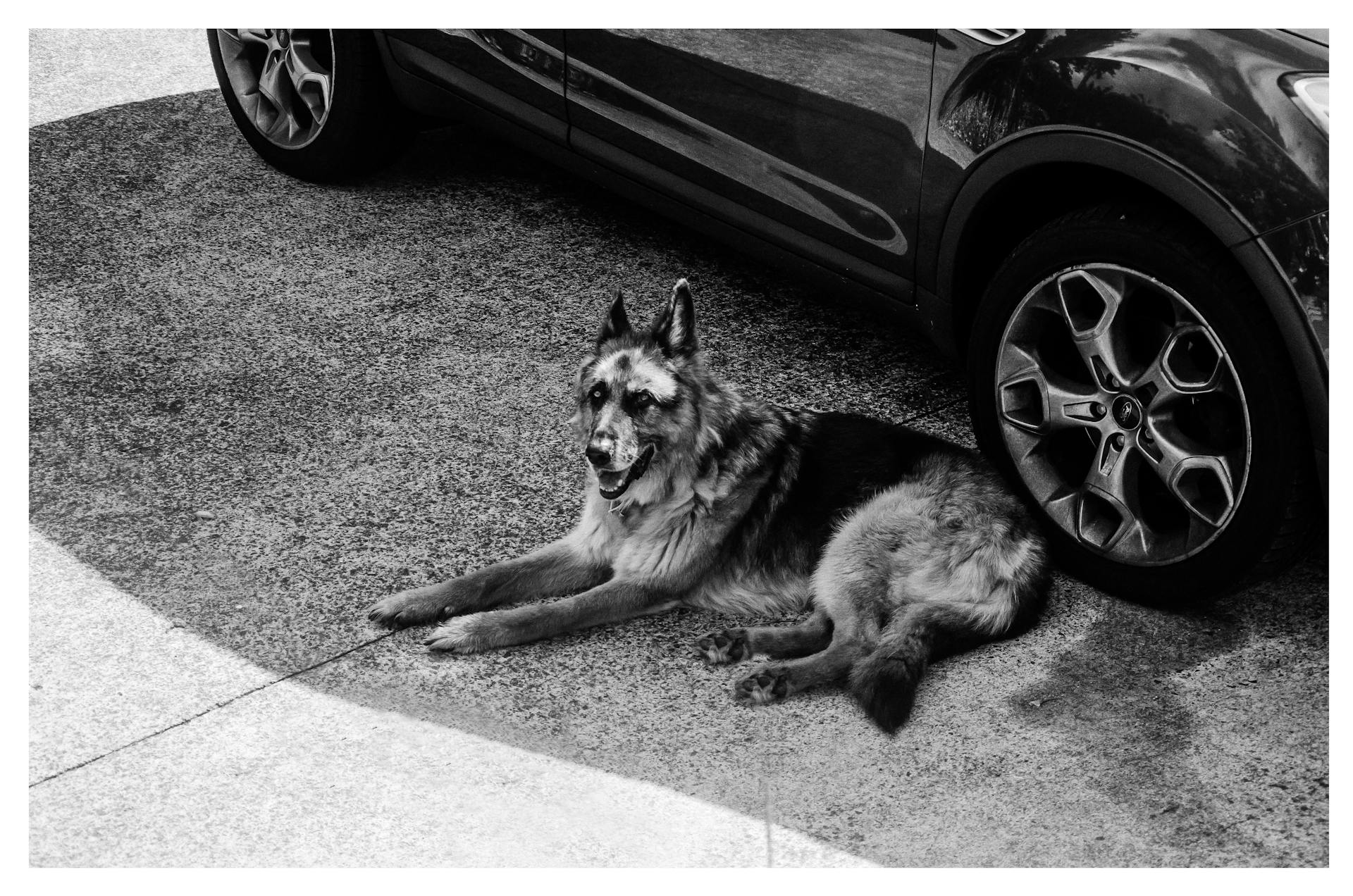
Their intelligence and obedience make them highly trainable, but they can test a handler's determination if not provided with clear guidance. German Shepherds are not overly noisy or excitable, but they will bark in response to perceived threats.
As a breed, German Shepherds are highly intelligent and obedient, but some individuals can be overly aggressive towards people and other pets if not properly trained. They're not inclined to become immediate friends with strangers.
Their protective nature makes them a popular choice for police and military forces, but it's essential to provide them with proper training and socialization to prevent misdirected aggression. German Shepherds are natural watchdogs and can be trained to alert their owners to potential threats.
Overall, German Shepherds are a versatile breed that excels in various roles, from search and rescue to service dogs and actors. With proper training and care, they can thrive as loving and loyal companions.
Curious to learn more? Check out: Books on Training German Shepherds
Naming
The German Shepherd breed has had its fair share of name changes over the years.
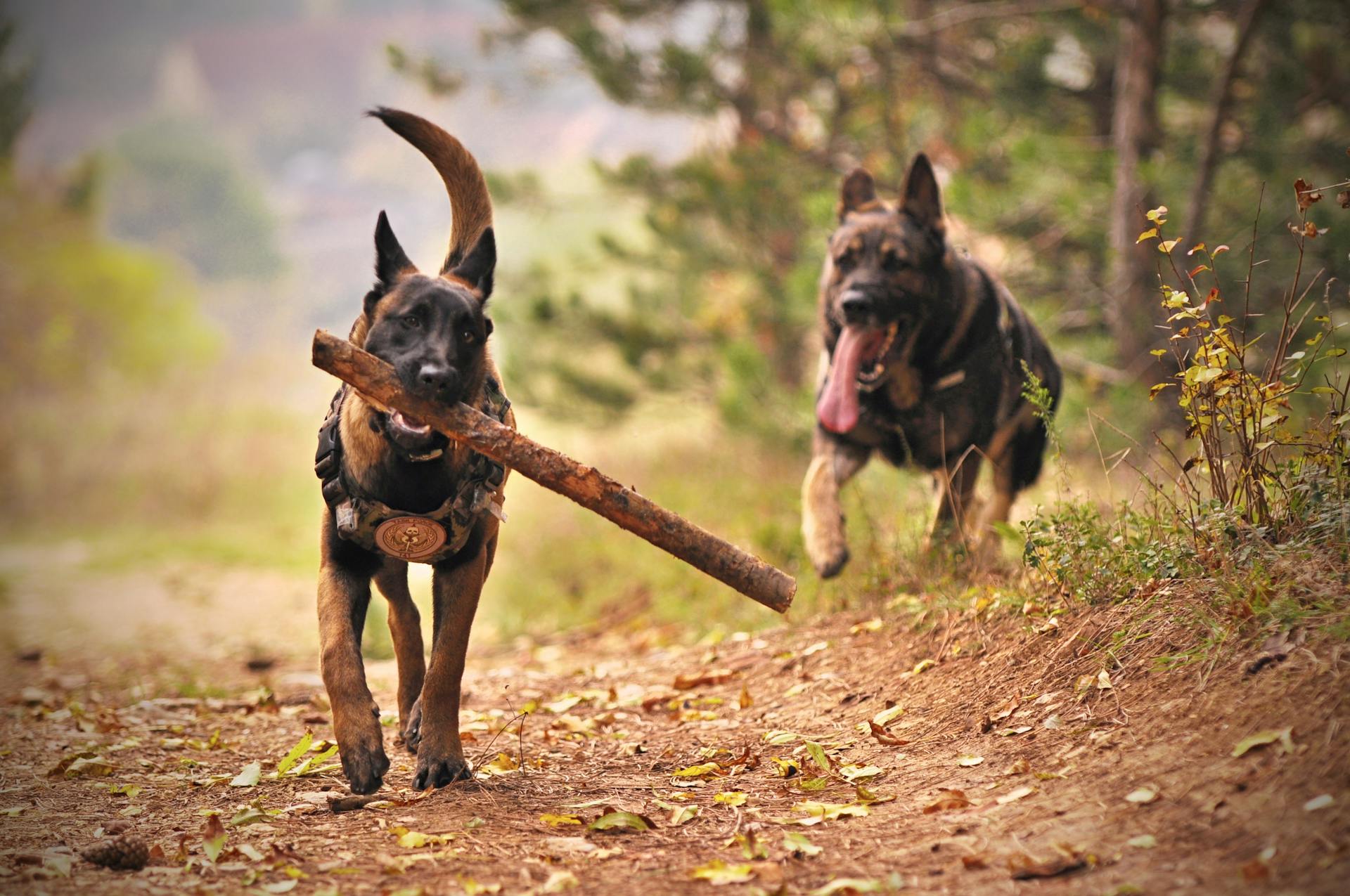
The original name given to the breed by von Stephanitz was Deutscher Schäferhund, which translates to "German Shepherd Dog".
At the time, all other herding dogs in Germany were referred to by this name, earning them the nickname Altdeutsche Schäferhunde, or old German herding dogs.
The name "German Shepherd" was later dropped due to anti-German sentiment during World War I, and the breed was renamed Alsatian Wolf Dog.
The "wolf dog" part of the name was eventually dropped, but the name Alsatian stuck for five decades.
In 1977, dog enthusiasts successfully lobbied for the breed to be registered again as German Shepherds.
Expand your knowledge: Dog Sledding Name
Size and Appearance
German Shepherds are known for their striking appearance and impressive size, falling within the medium to large dog category. They typically stand between 22 to 26 inches tall at the shoulders, with males often being slightly taller than females.
Their weight is equally notable, ranging from 50 to 90 pounds, with males tending to be heavier than females. This substantial weight contributes to their muscular appearance, reflecting their historical role as herding and working dogs.
Explore further: Rat Terrier Weight
German Shepherds are longer than they are tall, with an ideal proportion of 10 to 8+1⁄2. They have a domed forehead, a long square-cut muzzle, and a black nose. Their eyes are medium-sized and brown, and their ears are large and stand erect.
Here are some common coat types and colors found in German Shepherds:
- Saddle black-and-tan coat
- Black mask and sable
- Solid black
- Bi-colour
- Long-haired black-and-tan
Description
German Shepherds are medium to large-sized dogs, with a height at the withers ranging from 55-65 cm (22-26 in) depending on their sex. Males typically stand between 60-65 cm (24-26 in) tall, while females are slightly shorter at 55-60 cm (22-24 in).
Their proportion is ideal at 10 to 8+1⁄2, making them longer than they are tall. German Shepherds can reach sprinting speeds of up to 30 miles per hour, which is impressive for their size.
A German Shepherd's head is domed, with a long square-cut muzzle and strong jaws. They have a black nose and medium-sized brown eyes. Their ears are large and stand erect, open at the front and parallel, but they often are pulled back during movement.
German Shepherds have a distinctive double coat, which is close and dense with a thick undercoat. The coat is accepted in two variants: medium and long. The long-haired variety is rarer and has a different gene than the standard-coated dogs.
Here are some common coat colors and patterns found in German Shepherds:
- Saddle black-and-tan coat
- Black mask and sable
- Solid black
- Bi-colour
- Long-haired black-and-tan
Size
German Shepherds are a medium to large breed, with a strong and robust build that exudes elegance and power. They typically stand between 22 to 26 inches tall at the shoulders.
Males tend to be slightly taller than females, with a height range of 56 to 66 cm. Their weight range is equally impressive, usually falling between 50 to 90 pounds.
Females are generally lighter, weighing between 23 to 41 kg. Their weight and height contribute to their substantial and muscular appearance, reflecting their historical role as herding and working dogs.
Their well-proportioned body structure, characterized by a level back, strong hindquarters, and deep chest, emphasizes their agility and strength. This blend of physical prowess and mental acuity positions them as versatile companions.
Related reading: Xl Bully Height
White Swiss
The White Swiss Shepherd Dog is a variety of the German Shepherd bred in Switzerland.
It descends from the American White Shepherds. The first stud dog of what was to become the breed was an American dog born in 1966 and imported to Switzerland.
The White Swiss Shepherd Dog is recognized by the Fédération Cynologique Internationale as a separate breed. It gained recognition in 2003.
It's now recognized by a number of national kennel clubs.
Intriguing read: Bernese Mountain Dog vs Swiss Mountain Dog
Breed Organizations
Breed Organizations play a vital role in the German Shepherd community. They provide a platform for enthusiasts, breeders, and owners to share knowledge and promote responsible ownership.
Reputable breeders are often associated with these clubs, as they adhere to strict standards for breeding healthy, well-socialized puppies. Backyard breeders, on the other hand, prioritize profit over the well-being of their dogs.
The German Shepherd Dog Club of America and the World Union of German Shepherd Associations are two notable clubs that promote the breed's integrity and advocate for its well-being. These clubs foster a sense of camaraderie among members and provide a resource for learning about responsible dog ownership.
- German Shepherd Dog Club of America
- World Union of German Shepherd Associations
Special Considerations
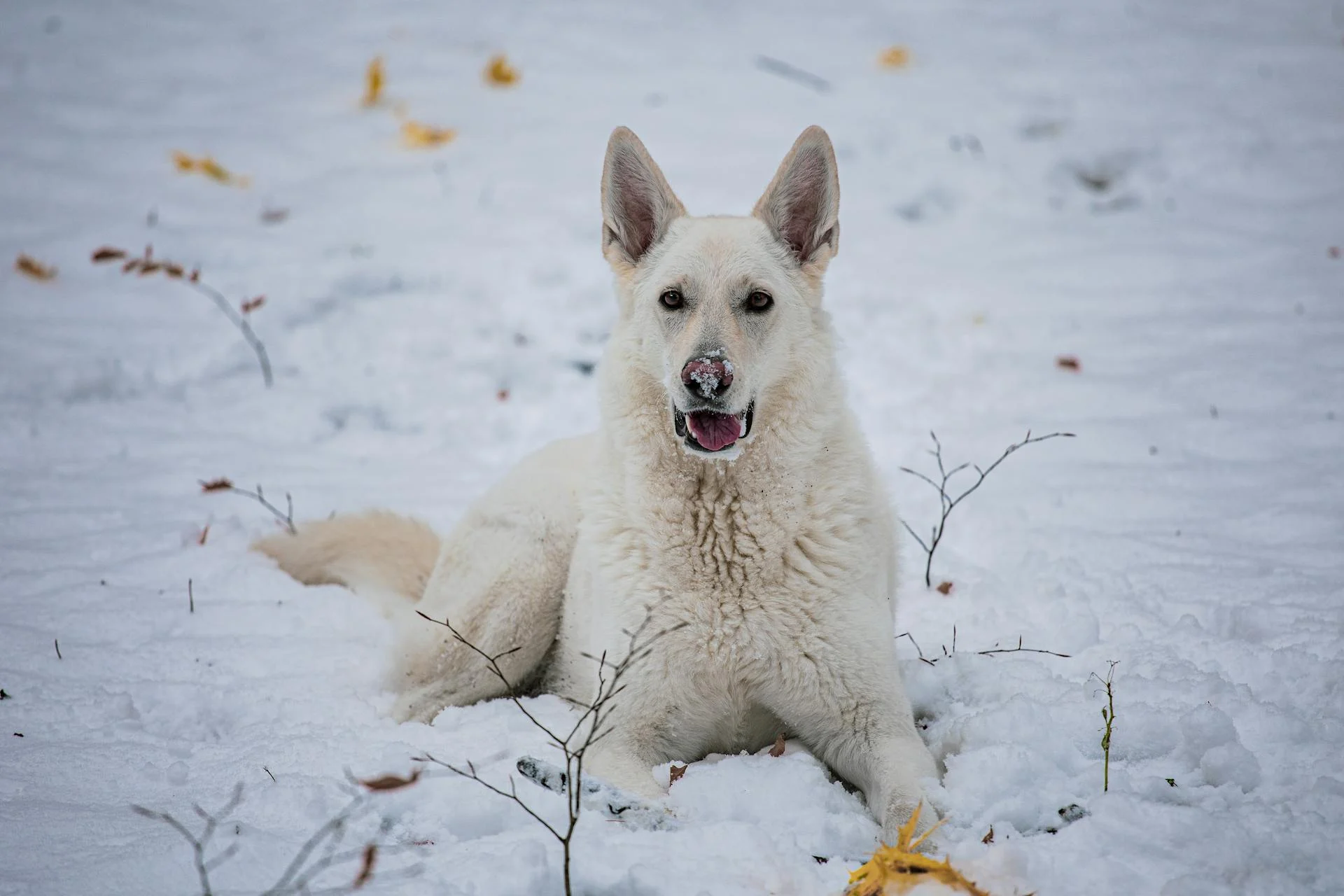
German Shepherds can be great family pets, but their temperament can range from calm and patient to playful and rambunctious, so it's essential to monitor their behavior and socialization.
You should always supervise interactions between children and your German Shepherd, even if you know them to be a well-behaved dog.
Teaching your child to be gentle with your family pet can help prevent harm to both the child and the dog.
Socializing your German Shepherd puppy from a young age can ease their nerves when around new people and dogs.
If you're having behavioral issues as your dog gets older, consider reaching out to a trainer or dog behaviorist.
German Shepherds aren't hypoallergenic dogs, and their double coat can cause allergic reactions, especially during shedding season.
To alleviate dog allergies in your home, try the following:
- Keep your dog out of your bedroom and off your bed and pillows.
- Vacuum and steam-clean your carpet frequently.
- Change your clothes and wash your hands after playing with your dog.
- Use an air filter in your home to capture pet allergens.
- Talk to your doctor about allergy medication or other treatments.
- Bathe your dog regularly to reduce dander and pollen on their coat.
Working and Training
German Shepherds are highly trainable and excel in various working roles, including police work, military duty, and search and rescue operations.
They are particularly well-suited for police work, being used for tasks such as tracking criminals, patrolling troubled areas, and detection and holding of suspects.
Their keen sense of smell and ability to work regardless of distractions make them ideal for scent-work roles like search and rescue, narcotics detection, and explosives detection.
German Shepherds are also used as guide dogs, although they are not as widely used for this purpose as they once were, with around 15% of dogs trained by Guide Dogs of America in 2013 being German Shepherds.
In their early days, German Shepherds were the breed of choice for guide dogs, but they were later found to be less suited for this role due to their high levels of aggression and defensive behavior.
Working
German Shepherds are a popular breed for working dogs due to their intelligence, loyalty, and trainability. They're often used for police work, tracking criminals, and detecting hazards.
In fact, thousands of German Shepherds have been used by the military for scout duty, warning soldiers of enemy presence or booby traps. Some have even been trained to parachute from aircraft or serve as anti-tank weapons.
German Shepherds excel in scent-work roles, including search and rescue, narcotics detection, and explosives detection. Their keen sense of smell and ability to work in distracting environments make them well-suited for these tasks.
Here are some examples of German Shepherds in action:
- Tracking criminals and patrolling troubled areas
- Warning soldiers of enemy presence or booby traps
- Searching for narcotics, explosives, or other substances
- Rescuing people from disaster sites
In the past, German Shepherds were also used as guide dogs for the visually impaired. However, they were found to be more suited to police work due to their high levels of aggression and defensive behavior.
Return
Returning home after a long day of work or training, you'll want to make sure your German Shepherd has a comfortable and clean environment to relax in. Regular brushing is a must to manage their shedding, so be prepared to brush your dog two to three times a week.
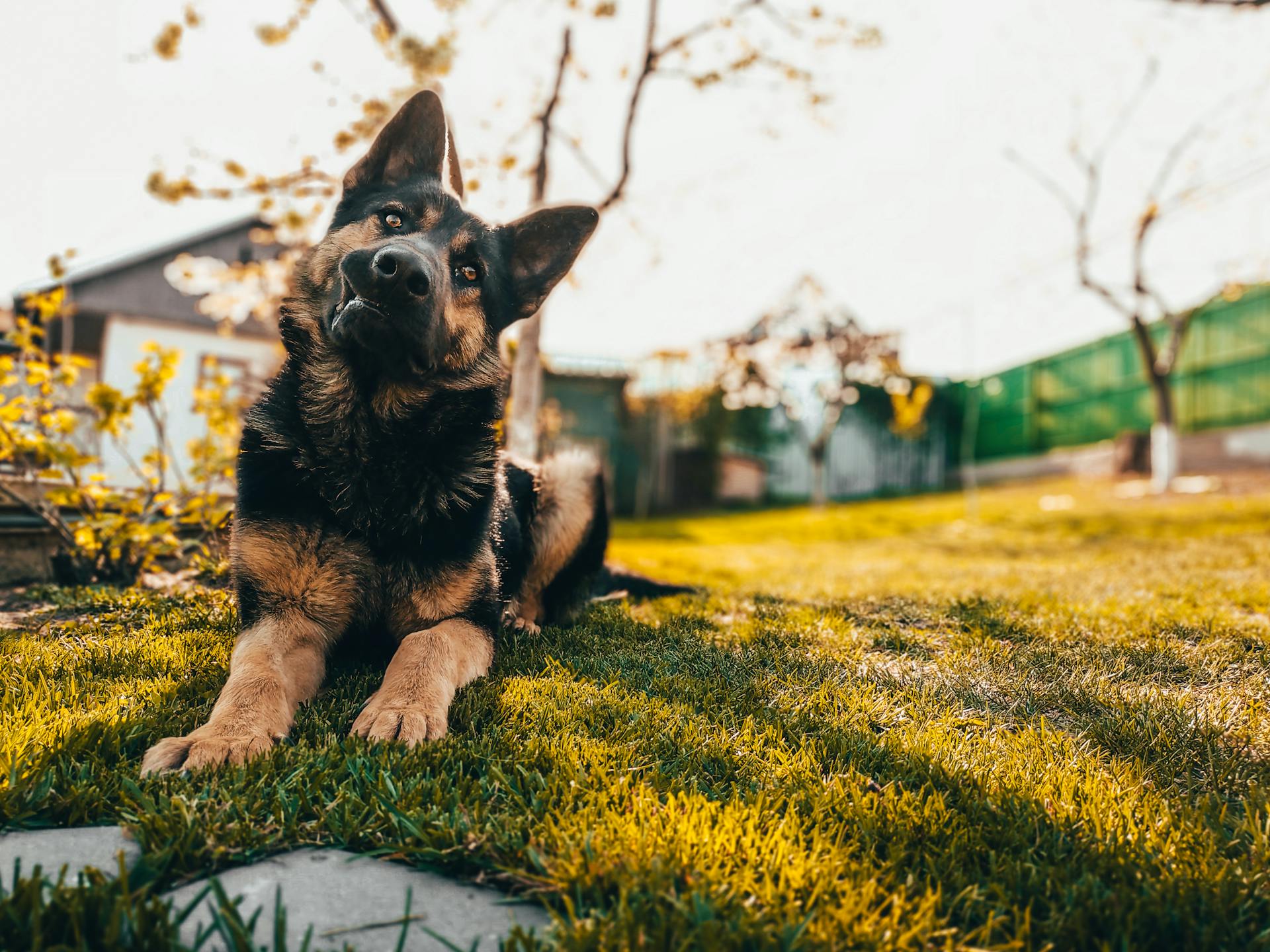
Their medium-length double coat serves as a natural shield against the elements, but it also means they'll be bringing in dirt and debris. A reliable vacuum cleaner is a lifesaver in this situation.
To maintain their hygiene, monthly nail trims and weekly ear checks are a must. Wipe out their ears with a damp cotton ball infused with gentle ear cleaner to prevent infections.
Their love of chewing is actually a plus for their dental health, but make sure to provide durable and secure chew toys or bones to combat tartar buildup.
Frequently Asked Questions
How strong is a German Shepherd?
A German Shepherd has a strong bite force of 238-291 PSI, making it a popular choice for law enforcement and protection work. This impressive strength is matched by its loyalty and obedience, making it a great family pet.
What are fun facts about German Shepherds?
German Shepherds are one of the smartest dog breeds, made famous by their role in World War I, and remain a popular favorite in America. They're also known for being highly intelligent and not inherently aggressive, making them a beloved companion for many families.
Why is German Shepherd special?
German Shepherds are special due to their exceptional courage, loyalty, and versatility, making them excel in various roles such as police and military work, guiding the blind, and search and rescue missions. Their unique combination of skills and temperament also makes them a beloved family pet.
What is the German Shepherd life history?
The German Shepherd originated as a herding dog, bred for qualities like intelligence, strength, and agility to effectively manage sheep. Its development was driven by the vision of Captain Max von Stephanitz to create a versatile and capable working dog.
What two breeds make a German Shepherd?
The German Shepherd breed originated from the combination of the Thuringian shepherd dog and the Wurtemberg shepherd dog. These two breeds were selectively bred to create the modern German Shepherd.
Featured Images: pexels.com

